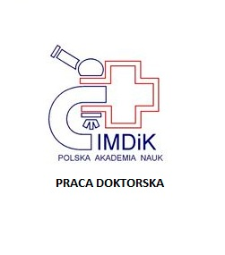
Obiekt
Tytuł: Efekty biologiczne translokacji białkowej C beta II do mitochondriów po epizodzie ischemiczno-reperfuzyjnym mózgu myszoskoczka
Współtwórca:
Zabłocka, Barbara (Promotor)
Wydawca:
Instytut Medycyny Doswiadczalnej i Klinicznej im. M. Mossakowskiego PAN
Miejsce wydania:
Opis:
Bibliogr. zawiera 256 pozycji ; 116 s.: il., fot., tabl.; 30 cm
Uzyskany tytuł:
Stopień studiów:
Typ obiektu:
Abstrakt:
Exitence of brain areas less sensitive to ischemia (such as CA2-4, DG region of hippocampus) offers hope for development of an ischemia effects treatment based on enhancement of endogenous adaptive response nervous cells. The variety of proteins, including protein kinases C (PKC) translocate to mitochondria following ischemia-reperfusion (I/R), which may lead to cell death or its survival. The aim of the study was to verify PKCbeta engagement in endogenous neuroprotection in CA2-4, DG region of hippocampus after I/R and to discover its mechanisms in mitochondria. Two experimental models were used: an in vivo-5-min. ischemia of gerbil brain and an in w=vitro-exitotoxicity evoked in organotypic hippocampal slice culture. Presented results show that immunoractivity and activity of PKCbeta increased in mitochondria of CA2-4, DG following I/R. A specific, peptide-inhibitor of PKCbetaII decreased postischemic translocation of the kinase to mitochondria and enhanced injury of neurons caused by I/R or excitotoxicityin the experimental models. What is more, PKCbeta II located inmitochondrial matrix after I/R.Due to this fact it was studied that PKCbeta II may interact with mitochondrial proteins (such as ATPase, pyruvate dehydrogenase, glutaminase0. Preliminary metabolomics results suggested changes in energy metabolism, mainly pyruvate alternations in CA2-4, DG region in which PKCbeta II may be engaged. Presented research indicates thatPKCbeta II translocation to mitochondria is an element of endogenous neuroprotection in the region of hippocampus less prone to I/R ( CA2-4, DG). Further development of research regarding neuroprotective mechanism of PKCbetaII can reveal new molecular factors, which may become targets of pharmacological treatment imtendent for patients sufferin from braim ischemia.
Czasopismo/Seria/cykl:
Format:
Identyfikator zasobu:
Źródło:
INDiK PAN, coll no. ZS 395 ; kliknij tutaj, żeby przejść
Prawa:
Creative Commons Attribution BY 4.0 license
Zasady wykorzystania:
Copyright-protected material. [CC BY 4.0] May be used within the scope specified in Creative Commons Attribution BY 4.0 license, full text available at: ; -
Digitalizacja:
Instytut Medycyny Doświadczalnej i Klinicznej im. M. Mossakowskiego Polskiej Akademii Nauk
Lokalizacja oryginału:
Library of the Mossakowski Medical Research Institute PAS
Dofinansowane ze środków:
Dostęp:
Kolekcje, do których przypisany jest obiekt:
- Repozytorium Cyfrowe Instytutów Naukowych > Kolekcje Partnerów > Instytut Medycyny Doświadczalnej i Klinicznej PAN > Prace dyplomowe > Prace doktorskie
- Repozytorium Cyfrowe Instytutów Naukowych > Piśmiennictwo > Prace dyplomowe
Data ostatniej modyfikacji:
5 sty 2023
Data dodania obiektu:
31 maj 2019
Liczba pobrań / odtworzeń:
746
Wszystkie dostępne wersje tego obiektu:
https://rcin.org.pl/publication/94429
Wyświetl opis w formacie RDF:
Wyświetl opis w formacie RDFa:
Wyświetl opis w formacie OAI-PMH:
Obiekty Podobne
Konopacki, M. [Mieczysław]
Gajkowska, Barbara Mossakowski, Mirosław Jan (1929–2001)
Sęk, Aleksandra
Piecyk, Karolina
Prill, Monika
Kowalczyk, Joanna Ewa

 INSTYTUT ARCHEOLOGII I ETNOLOGII POLSKIEJ AKADEMII NAUK
INSTYTUT ARCHEOLOGII I ETNOLOGII POLSKIEJ AKADEMII NAUK
 INSTYTUT BADAŃ LITERACKICH POLSKIEJ AKADEMII NAUK
INSTYTUT BADAŃ LITERACKICH POLSKIEJ AKADEMII NAUK
 INSTYTUT BADAWCZY LEŚNICTWA
INSTYTUT BADAWCZY LEŚNICTWA
 INSTYTUT BIOLOGII DOŚWIADCZALNEJ IM. MARCELEGO NENCKIEGO POLSKIEJ AKADEMII NAUK
INSTYTUT BIOLOGII DOŚWIADCZALNEJ IM. MARCELEGO NENCKIEGO POLSKIEJ AKADEMII NAUK
 INSTYTUT BIOLOGII SSAKÓW POLSKIEJ AKADEMII NAUK
INSTYTUT BIOLOGII SSAKÓW POLSKIEJ AKADEMII NAUK
 INSTYTUT CHEMII FIZYCZNEJ PAN
INSTYTUT CHEMII FIZYCZNEJ PAN
 INSTYTUT CHEMII ORGANICZNEJ PAN
INSTYTUT CHEMII ORGANICZNEJ PAN
 INSTYTUT FILOZOFII I SOCJOLOGII PAN
INSTYTUT FILOZOFII I SOCJOLOGII PAN
 INSTYTUT GEOGRAFII I PRZESTRZENNEGO ZAGOSPODAROWANIA PAN
INSTYTUT GEOGRAFII I PRZESTRZENNEGO ZAGOSPODAROWANIA PAN
 INSTYTUT HISTORII im. TADEUSZA MANTEUFFLA POLSKIEJ AKADEMII NAUK
INSTYTUT HISTORII im. TADEUSZA MANTEUFFLA POLSKIEJ AKADEMII NAUK
 INSTYTUT JĘZYKA POLSKIEGO POLSKIEJ AKADEMII NAUK
INSTYTUT JĘZYKA POLSKIEGO POLSKIEJ AKADEMII NAUK
 INSTYTUT MATEMATYCZNY PAN
INSTYTUT MATEMATYCZNY PAN
 INSTYTUT MEDYCYNY DOŚWIADCZALNEJ I KLINICZNEJ IM.MIROSŁAWA MOSSAKOWSKIEGO POLSKIEJ AKADEMII NAUK
INSTYTUT MEDYCYNY DOŚWIADCZALNEJ I KLINICZNEJ IM.MIROSŁAWA MOSSAKOWSKIEGO POLSKIEJ AKADEMII NAUK
 INSTYTUT PODSTAWOWYCH PROBLEMÓW TECHNIKI PAN
INSTYTUT PODSTAWOWYCH PROBLEMÓW TECHNIKI PAN
 INSTYTUT SLAWISTYKI PAN
INSTYTUT SLAWISTYKI PAN
 SIEĆ BADAWCZA ŁUKASIEWICZ - INSTYTUT TECHNOLOGII MATERIAŁÓW ELEKTRONICZNYCH
SIEĆ BADAWCZA ŁUKASIEWICZ - INSTYTUT TECHNOLOGII MATERIAŁÓW ELEKTRONICZNYCH
 MUZEUM I INSTYTUT ZOOLOGII POLSKIEJ AKADEMII NAUK
MUZEUM I INSTYTUT ZOOLOGII POLSKIEJ AKADEMII NAUK
 INSTYTUT BADAŃ SYSTEMOWYCH PAN
INSTYTUT BADAŃ SYSTEMOWYCH PAN
 INSTYTUT BOTANIKI IM. WŁADYSŁAWA SZAFERA POLSKIEJ AKADEMII NAUK
INSTYTUT BOTANIKI IM. WŁADYSŁAWA SZAFERA POLSKIEJ AKADEMII NAUK


































